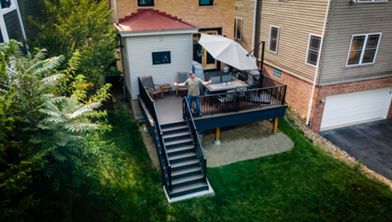Deck vs Patio: Which Is Right For You?
Weighing your outdoor options? Here’s how to choose between a deck and a patio for your perfect backyard escape.
Adding a deck or patio to your home is a great way to increase both its value and practicality. But which of these popular renovations is best for you and your home? To help decide whether a deck vs. patio should be your next project, it's important to understand the differences between these two unique features.
Follow along as we break down key distinctions, including costs, return on investment, and building factors, so you can decide which of these add-ons is right for you.
What Is the Difference Between a Deck and a Patio?
While these two common terms may seem interchangeable, they are distinct structures. Here are a few of the key differences between a patio vs. deck:
- Materials: A patio is a multi-purpose outdoor space typically delineated by concrete, brick, stone, tile, or another paved surface, whereas a deck is typically built using materials like pressure-treated wood or composite.
- Height: Patios are usually built directly at ground level, often working with the slope of their land. Meanwhile, decks are often built on top of a supporting structure, whether that be just off the ground or acting as a second-floor walkout for a multi-level deck. However, constructing a patio on uneven terrain can considerably increase the price of the project due to the amount of labor required to level the land.
- Location: While many patios can be built directly off a house, they can also be set in the middle of the yard as a standalone oasis. Freestanding decks can also be built in the middle of the yard, they are less common.
- Features: Decks and patios can have many of the same features, such as pergolas or privacy screens. However, patios tend to lack features like railings and stairs, as neither are required on ground-level structures.
- Maintenance: It’s often a bit easier to maintain a patio, especially compared to a lumber deck. Since patios are often made from concrete, you simply have to seal them and wash them off regularly. However, a deck can be constructed with materials that level the playing field. Composite deck boards, for example, don't require sealing and can be easily maintained with regular cleanings.
Whether you add a patio or a deck to your home, both structures can be built from a myriad of materials. Deciding between composite decking vs. a concrete patio or a composite deck vs. paver patio can be difficult. It’s not merely a matter of comparing material costs; you also have to look at factors like upkeep requirements and resale value return on investment (ROI) if you plan to sell your home.
Cost of Building a Deck vs. Patio
So which is cheaper: a deck or a patio? Once again, an accurate deck vs. patio comparison requires a look at several elements. The main differences come down to:
- Material cost: From brick or concrete patios to wood or composite decks, the materials you choose for your project will contribute significantly to your upfront cost.
- Size of the job: A larger project will likely require more materials and long-term maintenance, which adds to your total cost.
- Location: Depending on where you place your project, you may need to add supporting structures or extras to ensure safety and comfort. For example, building a ground-level patio is less expensive than a raised patio. Likewise, an ordinary deck with flat, straight lines is typically less expensive than a floating deck, a raised deck, or a deck that has a rounded shape.
- Extra features: Features such as built-in seating, multiple levels, or embedded lighting may add to the overall appeal of your project, but they will also increase your overall costs.
The average cost of adding a 10x10 patio is roughly between $2,000 and $5,000. By contrast, the average cost to build a deck of comparable size is somewhere between $2,100 and $3,800. Put another way, it costs roughly $21 - $30 per square foot (including substructure, decking, fascia, hardware and fasteners). to build a deck and roughly $15 per square foot to build a patio.
Deck vs. Patio: Which Has a Better Return on Investment?
All that said, directly comparing patio cost vs. deck pricing can be misleading. While patios are often cheaper in the short run, they aren’t necessarily in the long run.
According to financial advice site Bankrate, decks may cost more to build initially, but they tend to hold their long-term value better. Bankrate’s data shows composite decks offer a 66% return on investment (ROI) compared to 55% for a patio. This is because composite decking requires less long-term maintenance than wood decks while providing a higher aesthetic appeal than a concrete patio.
But not all deck vs. patio comparisons are one-to-one. Comparing a sophisticated deck and simple patio, for example, like a Trex composite deck vs. a concrete patio, is more complicated. Perhaps the biggest contributing factor to your deck or patio’s ROI will be maintenance costs, and to determine those, you’ll have to consider two things: the material you plan to build with and the region you live in.
While inexpensive materials may suggest a greater ROI upfront, that might not necessarily be true once you factor in annual maintenance costs. Likewise, regional considerations like your local climate (i.e., whether you experience snowfall, lots of direct sunlight, or significant rain) can affect your structure’s ROI, depending on the material you use to build it.
Think a Deck Is Right for You? Start Planning Your Dream Trex Deck
Patios are a good choice for some kinds of homes, and decks are a better choice for others. If you think a deck is the right choice for your home, the next step is to start exploring your options.
Start your exploration process by building a plan for your upcoming project. Try Trex’s online deck designer tool to build a virtual model of your future deck and dial in on the exact features and size that best suit your needs.
This content was partially or fully generated by AI and has been reviewed by our team to ensure accuracy and relevance.




































